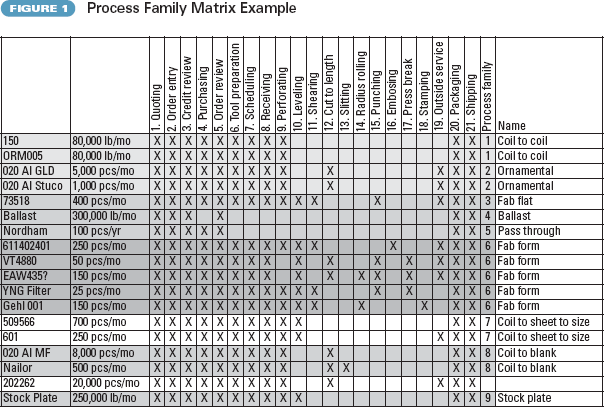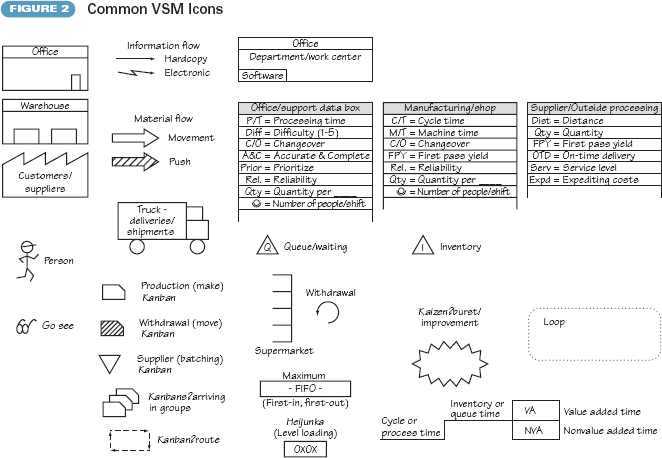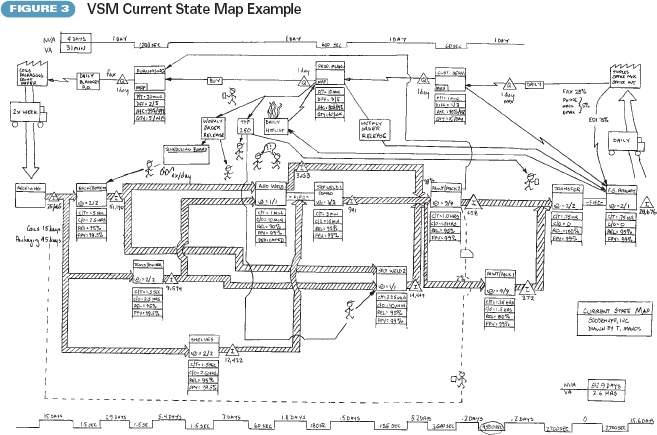How To Draw Future State Value
What is Value Stream Mapping (VSM)?
Value stream mapping (VSM) is divers as a lean tool that employs a flowchart documenting every step in the process. Many lean practitioners run into VSM as a cardinal tool to place waste, reduce process cycle times, and implement process improvement.
VSM is a workplace efficiency tool designed to combine textile processing steps with information flow, forth with other of import related data. VSM is an essential lean tool for an organization wanting to plan, implement, and improve while on its lean journey. VSM helps users create a solid implementation plan that volition maximize their available resource and help ensure that materials and fourth dimension are used efficiently.
Assisting Applications of Lean Value Stream Mapping
The original VSM template was created past Toyota Motor Visitor and implemented via material and process flowcharts. This VSM illustrated the necessary process steps that existed from order entry to terminal product delivery and was useful for gaining a wide-reaching view of the company's activities. It allowed Toyota to remove nonessential activities that created waste while maintaining the manufacturing process.
The "value stream" portion of the VSM system centers on how value can exist added to a production or service by irresolute the marketplace form or function to see the client's needs. This includes calculation features and functionality to a product or service that do good the customer without increasing wasted fourth dimension and materials (also called muda, the Japanese term for waste product) on the company's side.
Scoping Out Your Value Stream Map
Understanding the scope of the value stream under exam is a good start when planning your lean process or value stream map. This map is a single area in your system. However, when multiple plants, customers, or suppliers are included, an extended level map is created.
Consider an extended level map equally the view of the values stream at 60,000 feet, the facility level map at xxx,000 anxiety, and the procedure level map at ten,000 feet. It is all-time to showtime at diagramming a facility level map before attempting to draw a procedure level map or extended level map so you practise not optimize one surface area and suboptimize another.
Step i: Class a Team to Create the Lean Value Stream Map
Form a cross-functional team of high-level managers and supervisors from throughout your company. Representatives from multiple departments, such as sales, customer service, inventory, operations, and beyond, volition help ensure that information can be passed freely back and forth, and that items don't slip through the cracks. Consider also calculation important suppliers to this group considering an outside perspective can be helpful.
- The ideal squad size is nigh x members. Small teams can miss important items, while large teams can end upwards being hard to manage and coordinate.
Stride 2: The Kaizen Kick-Off – VSM Planning
After you've formed your VSM team, your next step is to hold a three-day kaizen event (see Table 1). Kaizen is Japanese and means "change for the better." During a kaizen, squad members begin developing current and hereafter plans.
Note: It's important to include an individual with VSM feel to help facilitate the kaizen event.

Value Stream Mapping, The Kaizen Kicking-Off
At the kaizen issue, the squad must consummate four of import steps:
- Make up one's mind the process family.
- Describe the current state map.
- Make up one's mind and draw the future state map.
- Draft a plan to go far at the hereafter state.
One time these iv steps accept been completed and the team agrees with the plans and tactics, the VSM team tin can keep to the next steps.
Footstep 3: The Process Family – VSM Planning
A procedure family unit, also known as a product family unit, is a grouping of products or services that go through the same or similar processing steps. To determine your process family, create a matrix similar to the case shown in Figure 1 beneath.

Value Stream Mapping, The Process Family unit Matrix
Along the top row, write all the procedure steps your organization performs from a xxx,000-foot point of view.
- In the showtime column, write down the parts (e.thou., components, stock keeping units, finished skilful items, or services) your arrangement makes or provides.
- Place an Ten in the corresponding box if the part goes through the processing step.
It's important that this step is practical to all cantankerous-functional teams and key areas inside your visitor. This helps ensure all vital steps are included and no steps are overlooked.
Step four: Identifying Similarities
Examine the matrix and look for sections that have like or identical processing steps. Also expect for sections that share almost fourscore% of the steps. Consider items that share many of the same steps and procedures that can be created together—by the same workers using like or related steps—more than efficiently in a manufacturing prison cell.
Once yous've identified similarities, the team must then identify which process family it will concentrate on beginning. The list beneath represents some common reasons for picking sure areas, and they are areas that the VSM team should consider:
- Biggest "bang for the buck"
- Largest reduction in atomic number 82 fourth dimension or inventory
- Biggest impact to the customer
- Highest probability for success
- Most visible to stakeholders
- New production or service line
- Volume or quantity
Step 5: Creating the Current Land Map – VSM Planning
To create a current country map, collect the data and data past "walking the flow" and interviewing the people who perform the job. This is beneficial for 2 reasons:
- The squad will have the opportunity to see the entire process and look for waste.
- The people who actually perform the work (e.g., operators, assemblers, technicians) tin can answer questions and clarify whatsoever misconceptions or preconceived notions on how tasks are performed.
When your team is "walking the flow," exist sure to get together high-value information from employees, including:
- Wheel time or processing time
- Changeover time
- Reliability of equipment
- Offset pass yield
- Quantities
- Number of operators and shifts
- Difficult copy information
- Electronic information
- Inventory levels
- Queue or waiting times
The information gathered does not have to exist perfect or overly detailed. As long every bit the data provides a relatively clear movie of major issues, the team tin can begin edifice its lean process map.
Stride 6: Start by Creating the Basic VSM Template
One time your team has gathered and reviewed the data obtained while "walking the period," brainstorm drawing the value stream map. Figure 2 below shows some common examples and strategies with VSM template development.

Value Stream Mapping Template Evolution
Key areas on the map are:
- The upper-right corner for client information
- The upper-left corner for supplier information
- The top half of the paper for information menses
- The bottom half for material (or product) flow
- The gutters on elevation and bottom to calculate value added and nonvalue added time
Calculate the bike time vs. the inventory time (in days) for the material and information menstruation. Each VSM will look slightly different depending on the procedure and how it was drawn. Effigy three beneath features an example of a VSM electric current land map used for a metal fabricating visitor.

Value Stream Mapping Electric current State Map Example
If this is one of the squad's first VSM kaizens, have the facilitator depict the map on a large dry-erase board and then have the team members draw each of their own maps on paper (ideally in pencil). The current land map is commonly completed by the 2nd mean solar day, only it may need refining.
Footstep 7: Creating the Hereafter Land Map
- What is the takt fourth dimension?
- Takt is the German language word for the baton a conductor uses to control his orchestra's speed, beat, and timing. Takt time refers to how often a part or component must be produced to meet your customers' demand. The formula is the time available (per shift) divided past the demand (per shift). For example:
- 22,000 seconds (time bachelor)
- ÷ 200 pieces (demand)
- = 110 seconds/piece
- Takt is the German language word for the baton a conductor uses to control his orchestra's speed, beat, and timing. Takt time refers to how often a part or component must be produced to meet your customers' demand. The formula is the time available (per shift) divided past the demand (per shift). For example:
- Are in that location bottlenecks or constraints?
- From the data drove during the kaizen, await at the cycle times or processing times. If whatsoever of these are greater than your takt fourth dimension, you have a candidate for a bottleneck or constraint. This may be causing overproduction waste or work in process (WIP) in some areas, or extra processing time, such as overtime, to see demand.
- Where tin inventory (or queue time) exist reduced or supermarkets used?
- A supermarket is a controlled inventory organization—the downstream procedure removes items from the shelf and the process owners upstream replenish that amount to the supermarket.
- Await at raw material, WIP, buffer stock, condom stock, and finished goods inventories to see whether these tin can be reduced. Does information technology brand sense to put in a supermarket replenishment system?
- The key is to observe means to reduce inventory in a logical mode. Also look for opportunities for paperwork to flow and non sit effectually, similar in batching.
- Where can you better menstruum?
- Is information technology possible to put materials into a cell or eliminate materials from stopping and waiting? If period comeback isn't possible, could a "start in, first out" lane be established between processes?
- What other improvements are required?
- For example, does the reliability of equipment need to be improved? Are the first laissez passer yield or quality levels acceptable? Is grooming in 5S (workplace system) needed? Does a new layout for an area need to be created?
On the VSM, place a kaizen burst (a gluey note or thought chimera) around any items to indicate improvement is needed. Items may include depression equipment reliability or first pass yield; long changeover times; big batches; any waste such as overproduction, movement, transportation, waiting, defects, or adjustments; and over or extra processing.
Step 8: Creating the VSM Draft Plan
During a typical VSM consequence, it is possible to create the typhoon plan based on the data from the future state map. The plan will need further refinement, particularly in determining resource required, such as time, people, and budgets. A proficient plan, as shown in the example beneath, will include the description of the project, proper noun of the project leader, possible squad members, a schedule (or Gantt chart) of events and deliverables, an estimate of costs, and the touch, goals, or benefits.
Source: https://asq.org/quality-resources/lean/value-stream-mapping
Posted by: leboeuffroir2002.blogspot.com


0 Response to "How To Draw Future State Value"
Post a Comment